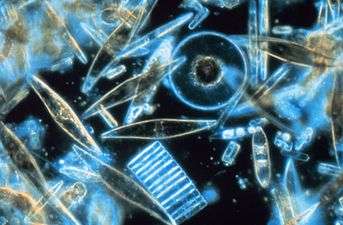Calanoida
| Calanoida | |
|---|---|
 | |
| Diaptomus | |
| Scientific classification | |
| Kingdom: | Animalia |
| Phylum: | Arthropoda |
| Subphylum: | Crustacea |
| Class: | Maxillopoda |
| Subclass: | Copepoda |
| Superorder: | Gymnoplea Giesbrecht, 1882 [1] |
| Order: | Calanoida Sars, 1903 |
| Families | |
|
See text | |
| Wikispecies has information related to: Calanoida |
| Wikimedia Commons has media related to Calanoida. |
Calanoida is an order of copepods, a kind of zooplankton. They include around 40 families with about 1800 species of both marine and freshwater copepods.[2] Calanoid copepods are dominant in the plankton in many parts of the world's oceans, making up 55%–95% of plankton samples.[2] They are therefore important in many food webs, taking in energy from phytoplankton and algae and 'repackaging' it for consumption by higher trophic level predators.[2] Many commercial fish are dependent on calanoid copepods for diet in either their larval or adult forms. Baleen whales such as bowhead whales, sei whales, right whales and fin whales eat calanoid copepods.[2]
Calanoids can be distinguished from other planktonic copepods by having first antennae at least half the length of the body and biramous second antennae.[2] Their key defining feature anatomically, however, is the presence of a joint between the fifth and sixth body segments.[3] The largest specimens reach 18 millimetres (0.71 in) long, but most are 0.5–2.0 mm (0.02–0.08 in) long.[2]
Classification
Calanoida contains the following families, and the genus Microdisseta, incertae sedis.
- Acartiidae
- Aetideidae
- Arctokonstantinidae
- Arietellidae
- Augaptilidae
- Bathypontiidae
- Boholinidae
- Calanidae
- Calocalanidae
- Candaciidae
- Centropagidae
- Clausocalanidae
- Diaixidae
- Diaptomidae
- Discoidae
- Epacteriscidae
- Eucalanidae
- Euchaetidae
- Fosshageniidae
- Heterorhabdidae
- Hyperbionychidae
- Lucicutiidae
- Mecynoceridae
- Megacalanidae
- Mesaiokeratidae
- Metridinidae
- Nullosetigeridae
- Paracalanidae
- Parapontellidae
- Parkiidae
- Phaennidae
- Phyllopodidae
- Pontellidae
- Pseudocyclopidae
- Pseudocyclopiidae
- Pseudodiaptomidae
- Ridgewayiidae
- Ryocalanidae
- Scolecitrichidae
- Spinocalanidae
- Stephidae
- Subeucalanidae
- Sulcanidae
- Temoridae
- Tharybidae
- Tortanidae
References
- ↑ J. W. Martin & G. E. Davis (2001). An Updated Classification of the Recent Crustacea (PDF). Natural History Museum of Los Angeles County. pp. 132 pp.
- 1 2 3 4 5 6 John Mauchline (1998). "Introduction". The Biology of Calanoid Copepods. Advances in Marine Biology. 33. Elsevier. pp. 1–15. ISBN 978-0-12-105545-5.
- ↑ Barnes, Robert D. (1982). Invertebrate Zoology. Philadelphia, PA: Holt-Saunders International. p. 692. ISBN 0-03-056747-5.
External links
- Calanoida fact sheet – guide to the marine zooplankton of south eastern Australia
- Classification of Calanoida
- Key to calanoid copepod families
